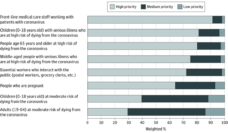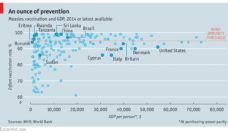Vaccination has long been portrayed as an invasion of personal liberty. Since the end of the Civil War, liberty and freedom have featured prominently in anti-vaccine propaganda. Opposition to vaccination on liberty grounds was brought to America from Great Britain by noted activists including William Tebb, who founded the Anti-Vaccination League of America in 1879, and Henry Bergh who objected to compulsory vaccination laws on the grounds that they undermine “every citizen’s inalienable right to ‘life, liberty, and the pursuit of happiness.”
While hashtags and memes trend on Twitter today, pamphlets and newspapers were the medium for anti-vaccine rhetoric at the turn of the 20th century. For example, American physician James Martin Peebles in his 1900 pamphlet entitled “Vaccination: A Cure and Menace to Personal Liberty,” depicted vaccinating doctors in league with the police, both reviled agents of state intrusion into bodily autonomy. The holding in the landmark 1905 Supreme Court decision Jacobson v Massachusetts, which upheld mandatory vaccination as a function of the state’s police power, only added fuel to the rhetorical fire.
In a peculiar mismatch, vaccination proponents of the time relied on medical claims to counter the liberty-based claims of anti-vaccine advocates. Henry Austin Martin, a prominent vaccine defender, did not address “medical liberty” at all. Instead, as chairman of the American Medical Association’s Committee on Vaccination, Martin focused on the safety and efficacy of immunization practices. This scientific defense of vaccination contrasts with the ideas set forth by Black vaccine proponents in the Antebellum North. There, vaccination was framed as a benefit and hallmark of American citizenship. Indeed, the ravages of smallpox were seen as the greater intrusion on liberty, not the laws that mandated immunization against the disease.
Anti-vaccine propaganda continues to rely on claims of liberty to discourage vaccination while pro-vaccine advocates rely on scientific messaging.
Professor James Colgrove and I used historical documents to analyze ongoing efforts to control the COVID-19 pandemic. We found that the same rhetorical mismatch in the 19th and early 20th centuries still exists today. Anti-vaccine propaganda continues to rely on claims of liberty to discourage vaccination while pro-vaccine advocates rely on scientific messaging. However, now amplified by the digital media of our time, this mismatch has a significant impact on public health. For example, the widely criticized National Vaccine Information Center discourages vaccination as they purport to be “defending truth and freedom.” These ideas translate into combative opposition against COVID-19 control measures as as vaccine requirements and mask mandates are sometimes violently opposed and proudly flouted on TikTok and elsewhere.
And yet, vaccine advocates still respond to their antagonists on scientific grounds. The “Myths and Facts” section on the CDC website contains questions about microchips and magnets and menstrual cycles, but nothing on social responsibility or a collective call to action. City health departments offer information on efficacy, cost, and vaccine appointments, but little in the way of the galvanizing rights talk that fires up anti-vaxxers.
This mismatch can no longer be ignored. Vaccine advocates will need to do more than proclaim the safety of their products to counter electrifying proclamations of liberty and freedom.
Photo via Getty Images














